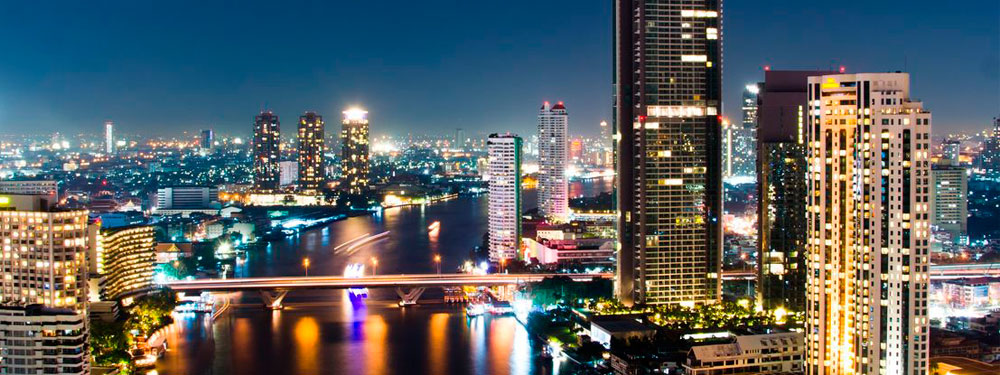In 2016, analysts and industry insiders predicted that it would be a great year for Thailand’s real estate market. The positive consensus was based on the government’s investment in mega projects, which included the building of 10 mass transit routes to link Bangkok with its suburbs, as well as the setting up of special economic zones (SEZs) to attract foreign investment.
Other development projects, such as high speed trains and motorways which aim to connect the nation with its neighbours, Cambodia, Myanmar, Malaysia and Laos were also expected to fuel growth in provinces until at least 2025.
Thongma Vijitpongpun, President and CEO of Pruksa Real Estate, shared his vision of development in the national property market while speaking in the Thai press,” We forecast that demand will grow by an average of 7 % a year in Bangkok and the suburbs until 2025, and during the same period the demand for homes in the provinces will grow by 3–5 %.”
Bangkok leading the development
The capital has been at the forefront of the property boom. Over 50 % of the BT620 billion nationwide residential market is based in Bangkok, while the rest is divided among the provinces. The socio-economic dynamics of the city have allowed developers to capitalize on the demand for cheaper housing.
Real estate firm Plus Property shared results of a survey of young professionals (aged 25–35) living in Bangkok. They indicated that 75 % of commuters using the Dark Green and Light Green BTS lines still do not own property.
The inability to purchase condominiums in the city has forced consumers to live in rented dormitories, apartments, or family homes. The
respondents shared that they prioritized living close to a BTS station for the commuting convenience to work and recreational centers and that the ideal transit time to work was 30 minutes [9–10 kilometres], whereas the ideal distance from the station was 500 meters.
The government’s expansion of the BTS to the Greater Bangkok Area offered consumers a shot at buying their own property without compromising on transit times. Developers had identified the need for low cost condominiums years earlier but were unable to create demand for
projects built outside the main city.
Chainid Adhyanasakul, CEO of Property Perfect, shared his foresight in an interview with Invest Thailand,” Middle income individuals will find living in the outskirts more attractive as the cost to their quality of life is reduced by the stronger transport links within the city centre. The opportunity is there for developers to build condominiums and single detached houses close to these transport links. That’s why most of our projects are in the Greater Bangkok area. I was able to anticipate this shift 20 years ago and bought a lot of land on the outskirts.”
Not all segments within the real estate sector are growing equally. According to Prasert Taedullayasatit, President of the Thai Condominium Association, sales of single houses and townhouses priced between BT2–3 million had risen since 3Q2015 as big developers moved into the segment.
Atip Bijanonda from Thailand’s Housing Business Association said the market for the low rise sector, which includes single houses and town apartments, was expected to grow by 5–10 % in 2016. ”In many provinces, condos will remain sluggish this year, while demand for single houses and townhouses will continue to grow as supply remains limited,” Bijanonda remarked.
In 17 provinces, the number of housing units launched declined by 29 % in the first three quarters of 2015, while the number of units purchased fell by 35 % in the same period.
Provinces securing foreign investment
A survey of the Government Housing Bank by the Real Estate Information Centre (REIC) revealed strong demand for land for the development of commercial and residential properties in 10 special economic zones
(SEZs): Tak (Mae Sot district), Songkhla (Sadao district), Mukdahan, Sa Kaew (Aranyaprathet district), Trat, Nakhon Phanom, Kanchanaburi, Chiang Rai, Nong Khai and Narathiwat.
Samma Kitsin, Director General of the REIC, shared that Tak and Nong Khai provinces have raked in considerable investments from local and foreign investors, particularly in the retail sector. In an interview with local press in December 2015, she said,” Robinson plans to open a branch in Mae Sot district, Tak, in 2017. MBK and MM Mega Market of TCC Land, owned by beverage tycoon Charoen Sirivadanabhakdi, also plan to invest more than BT10 billion to develop shopping centres and community malls in this province.”
Samma further added that the investments were a direct result of the government’s strategies to set up SEZs and develop infrastructure projects across Thailand worth over BT1 trillion between 2016 and 2019.
AEC and the positive fallout
The free trade zone advocated by the Asean Economic Community will mean an influx of foreign businesses moving to Thailand. Although the full potential of the agreement will take many years to achieve, the region’s combined GDP of $2.5 trillion and 600 million population with a growing middle class will be some of the many factors why its founders will want the pact to succeed.
With its strong infrastructure and comfortable living environment, Thailand is ready to attract multinationals who wants to make the country their base. CEO of Country Group Development, Ben Taechaubol, believes the country competes well with Singapore in its ability to draw interest from MNCs, stating the island state is too expensive and faces geographical limitations. Taechaubol has also called on the government to offer tax-based incentives to draw large companies to relocate their headquarters to Thailand.
Adhyanasakul believes the arrival of foreign workers will inject growth in two ways: real estate and mass transit will benefit as developers continue to fulfil demand for housing, while increased tourism will also generate demand for building properties in key tourism locations such as Bangkok, Pattaya and Chiang Mai.
